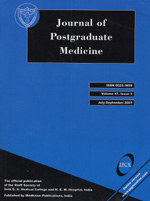
|
Journal of Postgraduate Medicine
Medknow Publications and Staff Society of Seth GS Medical College and KEM Hospital, Mumbai, India
ISSN: 0022-3859
EISSN: 0022-3859
Vol. 50, No. 1, 2004, pp. 57-59
|
 Bioline Code: jp04015
Bioline Code: jp04015
Full paper language: English
Document type: Research Article
Document available free of charge
|
|
|
Journal of Postgraduate Medicine, Vol. 50, No. 1, 2004, pp. 57-59
| en |
Thoracoscopic management of thoracic duct injury: Is there a place for conservatism?
Kumar S, Kumar A, Pawar DK
Abstract
Thoracic duct injury is a rare but serious complication following chest surgeries and major neck dissections. Clinically, it can present as cervical chylous fistula, chylothorax or chylopericardium. Without treatment, the mortality is up to 50% and thus, early aggressive therapy is indicated. Traditional conservative management includes low-fat diet, parenteral nutrition, careful monitoring of fluid and electrolytes, and drainage of the neck wound or chylothorax. Patients with failed conservative management require definitive treatment in the form of ligation of the thoracic duct, which has traditionally been done by thoracotomy. The advent of Video-Assisted-Thoracoscopic-Surgery (VATS) over the last decade has changed the approach towards the management of numerous chest diseases. Thoracoscopic ligation of the thoracic duct has also been reported. We report herein a case of postoperative cervical chylous fistula managed successfully by VATS thoracic duct ligation and present a systematic analysis of the English literature to highlight the current trends in the management of thoracic duct injury.
Keywords
Video-assisted-thoracoscopic-surgery, thoracic duct, chylous fistula, chylothorax
|
| |
© Copyright 2004 Journal of Postgraduate Medicine.
Alternative site location: http://www.jpgmonline.com
|
|
